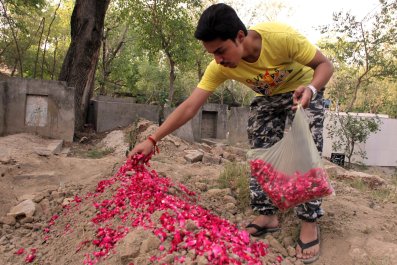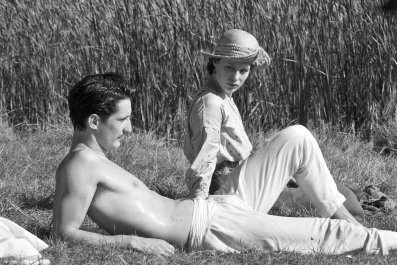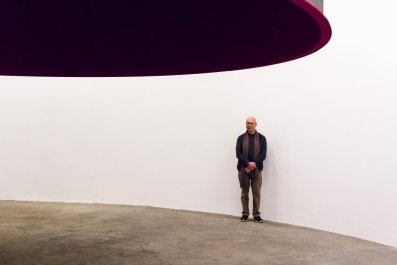Some people are distressed that while we can read history, we cannot smell it. "Our knowledge of the past is odorless," Cecilia Bembibre and Matija Strlic write in their new study on historic odors. Bembibre and Strlic, preservation scientists at University College London, want to change that.
We can look at photographs and drawings, read memoirs and listen to old recordings, but we can't conjure the odors of past events. We don't know what the air smelled like to Marco Polo as he traveled the Silk Road, or to the first northern Indians who gathered around Siddhartha Gautama in the fifth century B.C., or to the soldiers of the American Revolution who woke up at Fort McHenry to find that their flag was still there.
Many attempts have been made to tear down the wall separating our noses from our past. At the Jorvik Viking museum in York, England, the scent of medieval seafarers emanates from the timber and other artifacts found at the archaeological site on which the gallery was built. Urban planner Victoria Henshaw pioneered the creation of "urban smellscapes," city maps that distinguish neighborhoods by fragrance. In 2008, curator Robert Blackson, then at the Reg Vardy Gallery, in Sunderland, England, installed a scent-only exhibit—the gallery had no visual pieces—with artistic representations of the smell of communism, Cleopatra's hair, extinct flowers, the sun and other out-of-reach odors. Instead of the usual gift shop gallery guide, visitors could purchase a scratch-and-sniff book, called If There Ever Was, to remember the exhibit. At the National Museum of Australia, an exhibit on the cooking tools of trepang fishermen was accompanied by a station at which visitors could smell dried sea cucumber. "Smells hold information about who we are and the way we live," says Bembibre and Strlic. "They are part of our olfactory heritage."
Several countries are considering cataloging smells as part of their national heritage. In 2001, the Ministry of the Environment in Japan selected the country's 100 most significant fragrances. The fields of lavender in Furano city top the list; the ocean fog of the coastal Kushiro region is fourth. The list also includes handmade soba shops, an old bookstore and rainfall in rice paddy fields. Australia's Burra Charter, which guides the designation of historic landmarks, includes smell as a crucial feature of heritage. And UNESCO is considering adding the perfume-making practices of Grasse, France—home to the flowers responsible for Chanel No. 5—to its list of intangible cultural heritage. "Smell is finally being taken seriously as a topic of historical study," says Mark Jenner, a historian at the University of York.
Odor Wheel for History
But recording smells for posterity is difficult. Among the obstacles is vocabulary. English speakers, for example, have trouble describing odors and don't have a lot of words to do so (some other languages have a wider lexicon for smells). In 1984, sensory chemist Ann Noble, then at the University of California, Davis, created the Wine Aroma Wheel to help would-be oenophiles train their noses and brains to identify the notes infusing a given vintage. The wheel helps move the terminology from the more general "dry," for example, to the more specific characterization of "tea" or "hay."
Bembibre and Strlic, postdoctoral researcher and director, respectively, at the Institute for Sustainable Heritage, part of University College London, wanted to create an odor wheel for history. They began by creating one for old books, which connect to their time and place of publication. The wheel provides terminology for identifying odors emanating from the page, and links those odors to the chemicals that generate them. For example, an early 20th-century text that smells sweet and spicy may be more exactly defined as vanilla, bourbon, chocolate, caramel, cookies or almonds. If the smeller determines that the old book smells like almonds, then that could be the result of benzaldehyde, a chemical that forms when lignin, a component of some paper pulp, degrades. And knowing that benzaldehyde is responsible enables historians to preserve the odor.
To create the wheel, Bembibre and Strlic extracted the volatile organic compounds (VOC)—the chemicals responsible for odors—from old books. In one experiment, they encased a 20th-century Ethiopian manuscript in a bell jar. The containment allowed the VOCs to accrue toward the top of the jar. The team then used sensors to collect the VOCs present in the jar. Gas chromatography then separated the chemical mix into its component parts, providing the researchers with an exact readout of the chemicals contributing to the smell of the pages. In another experiment, the researchers kept a copy of Les Chardons du Baragan, a novel by Panai Istrati published in 1928, in a gas-sampling bag for two weeks, and again collected and analyzed the VOCs emanating from the book.
Having identified the chemicals responsible for the smell of Istrati's novel, Bembibre and Strlic created an "extract of historic book," as they write in their study, recently published in Heritage Science. The extract was presented alongside several other smell extracts, including fish market, dirty linen, coffee and HP sauce, a popular condiment in the U.K. Museum visitors were invited to characterize the smells, and those descriptions were then incorporated into the odor wheel.
The book odor wheel is, "a breakthrough as revolutionary as Edison's phonograph," says David Howes, who co-directs the Center for Sensory Studies at Concordia University in Montreal. "It will put smell on a par with hearing." Other smell experts are more skeptical about the methods for identifying an old book's smell. Because the 1928 novel was not hermetically sealed when it was first printed, the smell may stem from the used bookstore in London where the copy was purchased, says John Aggleton, who teaches cognitive neuroscience at Cardiff University. However, says Aggleton, although the experiment may not have extracted the smell of an old book, "the study does prove it can be done."
The researchers are continuing to validate their odor wheel by using it to reconstruct the smells of books and libraries. Creating a faithful rendition that someone instantly recognizes as "old book smell" is the next step in confirming that the wheel works. A perfumer will also create a version of the smell using the chemicals their research has identified.
Bembibre and Strlic are not the first people to be fascinated by the smell of old books. T. E. Lawrence's copy of James Joyce's Ulysses is famous for its aroma. More than the notes penciled in the margins or the occasional cookie crumb that spills from its pages, it's the smell —described as sweet and somewhat smoky—that captures the imaginations of those who hold it. The development of the odor wheel, says Howes, means odors like these can become part of our heritage through more than just words. Instead, he says, "the chemical composition of those pages has become a source of history itself."


















